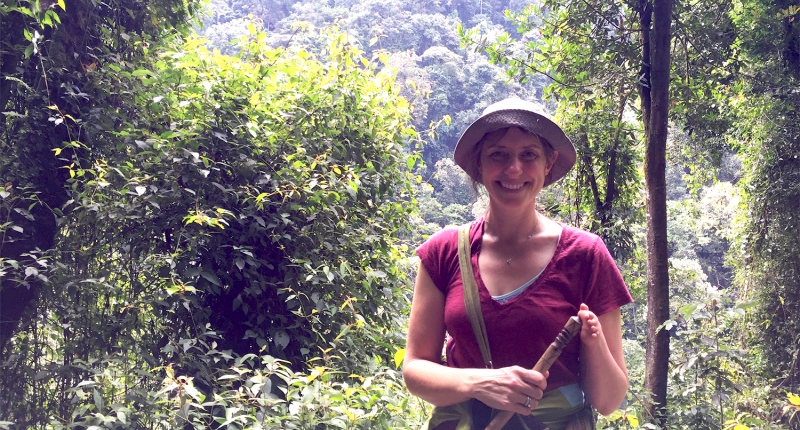NCEAS Portrait: Jensen Montambault, a Voyager in Conservation Science

Nicaragua, Rwanda, Tonga, Botswana, Guyana – Jensen Montambault’s passion for conservation has taken her to many remote places, such as these, to understand how human conflict and behaviors impact natural resources. The journey of figuring out the answers to intractable problems fuels her passion for this work.
For almost a decade, Jensen has worked as a senior scientist for The Nature Conservancy, and prior to that, she spent 13 years working on conservation and sustainable development projects in Latin America, the Caribbean, Africa, the South Pacific, and the United States.
Recently, Montambault has ventured into a new role, as the interim executive director for the Science for Nature and People Partnership (SNAPP), replacing now-retired Craig Groves. We spoke to Montambault for this month’s Portrait to get a better idea of what’s to come under her leadership.
Why did you get into your line of work?
Montambault: In college, I noticed many academics sticking with what was comfortable to them. Conservationists tended to talk to only to conservationists, ignoring the different lenses from people in business, engineering, sustainable development, and humanitarian work.
As I’ve traveled to field sites, I’ve realized that talking to people in their context gives you the opportunity to understand their perspectives. This provides new insight on what questions you can ask of existing data that will yield both interesting results and science that you can take action on. I’m passionate about science that adds value to conservation and people’s lives.
What questions are you most interested in solving?
Montambault: I would like to understand how to integrate more humanities into quantitative ecology. For example, many of the places with the highest biodiversity and rarest species have experienced recent conflict.
By studying the local music and art of the people in these places, we can learn about the impacts that local conflicts have on human behavior and decision-making in these regions. I want to know how to integrate these two realms of knowledge to leverage better conservation efforts.
Have you ever had an “ah-ha” moment that changed the way you think about your work?
Montambault: I used to lead rapid biodiversity assessments in remote tropical regions. On one occasion, we were in the Kanuku Mountains of Guyana when the tragedy of 9/11 happened. All flights in and out of the country were halted.
We decided to extend our field work since no one could leave the country, but because of the crisis at home and the extended stay, tensions among the team were high. Eventually, all the scientists started quarreling over our sampling design. The fish scientists wanted to leave quickly, while the mammologists wanted to stay, and the botanist had his earplugs in and was humming while pressing plants to avoid conflict.
It was during this time of high strain that I realized interdisciplinary science plays a crucial role in guiding experts on how to work together and solve real-world problems quickly.
When and how did you first discover the value of synthesis science?
Montambault: I’ve never worked with a tidy dataset in my life. That’s just the nature of conservation and development field programs.
One time, I was in St. John of the US Virgin Islands integrating bird data into the US Forest Service’s Forest Inventory and Analysis dataset. It was the end of an intense fieldwork season, and what I had to show for my time was a short snapshot of birds and a timeline of vegetation. I kept thinking, “we can’t wait 20 years to say something interesting about our data. By then the forest could be gone.”
So I assembled all the existing data I could on the birds of St. John and spent many weeks wrangling and harmonizing the different datasets. Finally, when I was done synthesizing everything, I realized that, without needing any more field work, we were able to talk about migratory bird trends and the importance of bird habitat over time. I was hooked!
What do you value most about your experience working with SNAPP?
Montambault: What I love most is working with people who have very different worldviews. It’s very rewarding to work with a conservation scientist, for example, who may not have collaborated with a social scientist before and facilitate a shared understanding of how to tackle a problem together.
I also enjoy the multi-institutional nature of SNAPP. It gives me the creative freedom to transcend the political structure of any institution.
What is one of the most inspiring or interesting places you’ve traveled to?
Montambault: Last spring, I traveled to Rwanda for the final meeting of the SNAPP Natural Capital Accounting working group. We traveled to Nyungwe Forest National Park, which is home to 13 primate species and the birthplace of the Congo River.
The national park is also surrounded by Burundi and Congolese refugee camps. In the refugee camps, the crowded, hot, and dusty blocks are crammed with school houses, medical tents, and emergency supply buildings that served as a stark reminder of the fragility of peace and prosperity.
I emerged from this trip thinking how the changing climate and depletion of natural resources will only serve to increase tension in places like this. Fortunately, groups like SNAPP help make these connections clearer and give us the opportunity to do something about it.
What are some of your favorite hobbies when you’re not traveling or working?
Montambault: My husband says growing fresh food is my hobby. We live on a small suburban lot and raise heritage-breed chickens, as well as grow shoehorn herbs, veggies, and berries. I try to incorporate something we have grown into every meal, and some days I realize I’ve spent over two hours chopping my own produce. But, it’s so worth it!
###
Alexandra Jamis was a Science Communications Fellow for the 2017-2018 school year.
NCEAS Portraits feature the people behind our work and impact.
